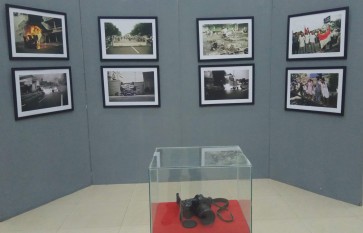Popular Reads
Top Results
Can't find what you're looking for?
View all search resultsPopular Reads
Top Results
Can't find what you're looking for?
View all search resultsRI Pavilion steals the show at World Expo
Spicy curiosity: An officer explains various types of spices to visitors at the Indonesian Pavilion in Expo Milano 2015
Change text size
Gift Premium Articles
to Anyone
 Spicy curiosity: An officer explains various types of spices to visitors at the Indonesian Pavilion in Expo Milano 2015. Held from May 1 to Oct.0 31, the expo aims to attract 20 million visitors.(JP/Hasyim Widhiarto)" border="0" height="341" width="512">Spicy curiosity: An officer explains various types of spices to visitors at the Indonesian Pavilion in Expo Milano 2015. Held from May 1 to Oct.0 31, the expo aims to attract 20 million visitors.(JP/Hasyim Widhiarto)
Spicy curiosity: An officer explains various types of spices to visitors at the Indonesian Pavilion in Expo Milano 2015. Held from May 1 to Oct.0 31, the expo aims to attract 20 million visitors.(JP/Hasyim Widhiarto)" border="0" height="341" width="512">Spicy curiosity: An officer explains various types of spices to visitors at the Indonesian Pavilion in Expo Milano 2015. Held from May 1 to Oct.0 31, the expo aims to attract 20 million visitors.(JP/Hasyim Widhiarto)The Indonesian Pavilion â one of the 70 independent pavilions at this yearâs Universal Exposition in Milan â stole the show at the worldâs biggest international exhibition.
As a participant of the Expo Milano 2015, which runs from May 1 until Oct. 31, the Indonesian Pavilion was built on a 1,175-square-meter plot of land located at the end of the 1.5-kilometer Decumanus, the main thoroughfare at the 110-hectare expo site where participating countries have built their pavilions.
Visitors entering the Indonesian Pavilion compound are welcomed by a bronze statue of the Javan rhinoceros, a critically endangered species famous for its single horn.
The center of activities at the pavilion, meanwhile, is located at the fish-shaped, one-story building that covers an area of 650-square-meter and is surrounded by a green landscape and playground.
The design of the pavilion symbolizes the interaction of farming and fishing communities across the archipelago and is in line with the theme of this yearâs expo: Feeding the Planet, Energy for Life, which stimulates participating countries to offer ideas and solutions to address universal problems on food security and sustainability by drawing upon its own culture and traditions.
Starting from the entrance of the pavilionâs main building, visitors can learn how Indonesia â the worldâs largest archipelago â put its name on the worldâs map as an important source of various kinds of food, including fish, rice and spices.
A dome-wall video at the front part of the building, for example, introduces visitors to the diversities of flora and fauna in the country, while the oculus exhibition in the other part of the building allows visitors to experience the beauty of Indonesian natural resources in 3D.
Many visitors, however, agree that it is the display of various kinds of local spices at the center of the pavilion that has captured their attention, at which they can observe, touch and smell every unique spice in its raw form.
To complete their experience at the pavilion, visitors can also visit a restaurant and several food stalls attached to the compound to taste popular Indonesian food, including fried rice, chicken satay, and rendang (beef simmered in coconut milk and spices).
Indonesian Pavilion director Budiman Muhammad said the venue, as of Saturday, had attracted almost 800,000 visitors, since it was opened in May.
âUnlike other pavilions that rely heavily on technology, like LEDs and hologram presentations, we ask our visitors to use their five senses to create their unique personal experience when visiting our pavilion,â Budiman told The Jakarta Post on Saturday.
âThey, for example, can touch and smell many spices that grow in many parts of the archipelago, play the traditional angklung bamboo instrument and taste the variety of Indonesian food.â
With less than three months remaining before the closing of the expo, Budiman said he was keen to see the pavilion attract at least 2 million visitors.
span class="caption">Spicy curiosity: An officer explains various types of spices to visitors at the Indonesian Pavilion in Expo Milano 2015. Held from May 1 to Oct.0 31, the expo aims to attract 20 million visitors.(JP/Hasyim Widhiarto) The Indonesian Pavilion ' one of the 70 independent pavilions at this year's Universal Exposition in Milan ' stole the show at the world's biggest international exhibition. World Expo, dubbed the world's third-biggest event after the World Cup and the Olympics, are organized by the Paris-based Bureau International des Expositions (BIE) and held once every five years for up to six months.
S
As a participant of the Expo Milano 2015, which runs from May 1 until Oct. 31, the Indonesian Pavilion was built on a 1,175-square-meter plot of land located at the end of the 1.5-kilometer Decumanus, the main thoroughfare at the 110-hectare expo site where participating countries have built their pavilions.
Visitors entering the Indonesian Pavilion compound are welcomed by a bronze statue of the Javan rhinoceros, a critically endangered species famous for its single horn.
The center of activities at the pavilion, meanwhile, is located at the fish-shaped, one-story building that covers an area of 650-square-meter and is surrounded by a green landscape and playground.
The design of the pavilion symbolizes the interaction of farming and fishing communities across the archipelago and is in line with the theme of this year's expo: Feeding the Planet, Energy for Life, which stimulates participating countries to offer ideas and solutions to address universal problems on food security and sustainability by drawing upon its own culture and traditions.
Starting from the entrance of the pavilion's main building, visitors can learn how Indonesia ' the world's largest archipelago ' put its name on the world's map as an important source of various kinds of food, including fish, rice and spices.
A dome-wall video at the front part of the building, for example, introduces visitors to the diversities of flora and fauna in the country, while the oculus exhibition in the other part of the building allows visitors to experience the beauty of Indonesian natural resources in 3D.
Many visitors, however, agree that it is the display of various kinds of local spices at the center of the pavilion that has captured their attention, at which they can observe, touch and smell every unique spice in its raw form.
To complete their experience at the pavilion, visitors can also visit a restaurant and several food stalls attached to the compound to taste popular Indonesian food, including fried rice, chicken satay, and rendang (beef simmered in coconut milk and spices).
Indonesian Pavilion director Budiman Muhammad said the venue, as of Saturday, had attracted almost 800,000 visitors, since it was opened in May.
'Unlike other pavilions that rely heavily on technology, like LEDs and hologram presentations, we ask our visitors to use their five senses to create their unique personal experience when visiting our pavilion,' Budiman told The Jakarta Post on Saturday.
'They, for example, can touch and smell many spices that grow in many parts of the archipelago, play the traditional angklung bamboo instrument and taste the variety of Indonesian food.'
With less than three months remaining before the closing of the expo, Budiman said he was keen to see the pavilion attract at least 2 million visitors.
Five years ago, the World Expo 2010 Shanghai China (WESC), for example, broke the record with 73 million tickets sold. At the same event, the four-story Indonesian Pavilion became one of the most popular pavilions, attracting over eight million visitors by the final day of the expo on Oct. 31, 2010.
Despite such an achievement, the Indonesian government surprisingly decided not to participate in the Expo Milano 2015, prompting an organization called the Archipelago Cultural Conservationists Cooperative (KPBN), which was led by late actor Didi Petet, to take over the management of the Indonesian Pavilion in 2014 after securing endorsement from the Trade Ministry.
Without financial support from state budget, the organizers of the pavilion were also struggling to continue the project before gaining support from major sponsors, including Artha Graha Network and PT Indofood Sukses Makmur.
The pavilion organizers also experienced difficulties in trying to complete preparations for the pavilion on time, as some of the main ornaments had not arrived at the Expo venue by the time the event officially kicked off.
Such behind-the-scene struggles, however, showed no trace on Saturday. Visitors continuously arrived at the Indonesian Pavilion throughout the day, enjoying the venue and enthusiastically asking the pavilion guides questions about some traditional features on display, including angklung, wayang (shadow puppet) and local spices.
'We even have to refill our nutmeg display because many visitors apparently took them home although they are supposedly not allowed to do so,' Budiman smiled.
Knut Sander, an expo visitor from Oslo, Norway, said his visit to the Indonesian Pavilion brought back memories of when he and his family visited Indonesia several years ago for vacation.
'When I touched and smelled the spices on display, it quickly reminded me of how delicious Indonesian food was,' he said.
Your Opinion Matters
Share your experiences, suggestions, and any issues you've encountered on The Jakarta Post. We're here to listen.
Thank You
Thank you for sharing your thoughts. We appreciate your feedback.
Share options
Quickly share this news with your network—keep everyone informed with just a single click!
Gift Premium Articles
to Anyone
Share the best of The Jakarta Post with friends, family, or colleagues. As a subscriber, you can gift 3 to 5 articles each month that anyone can read—no subscription needed!
Continue in the app
Get the best experience—faster access, exclusive features, and a seamless way to stay updated.









